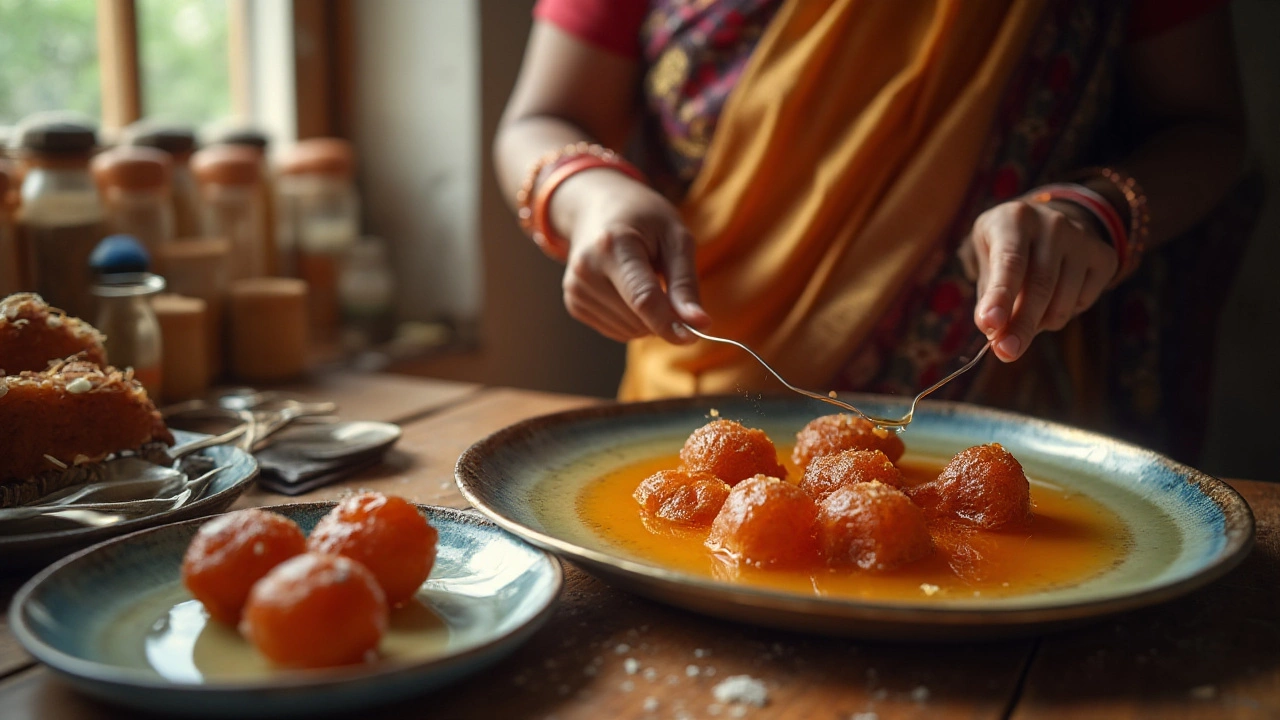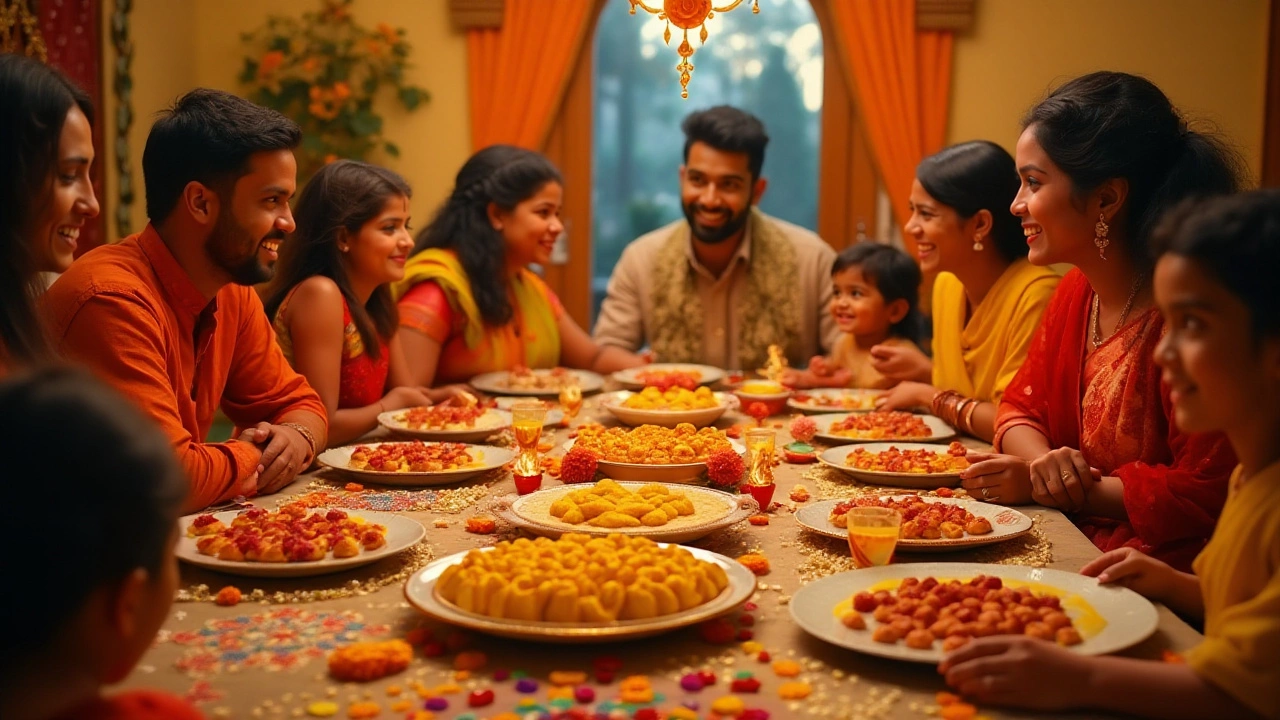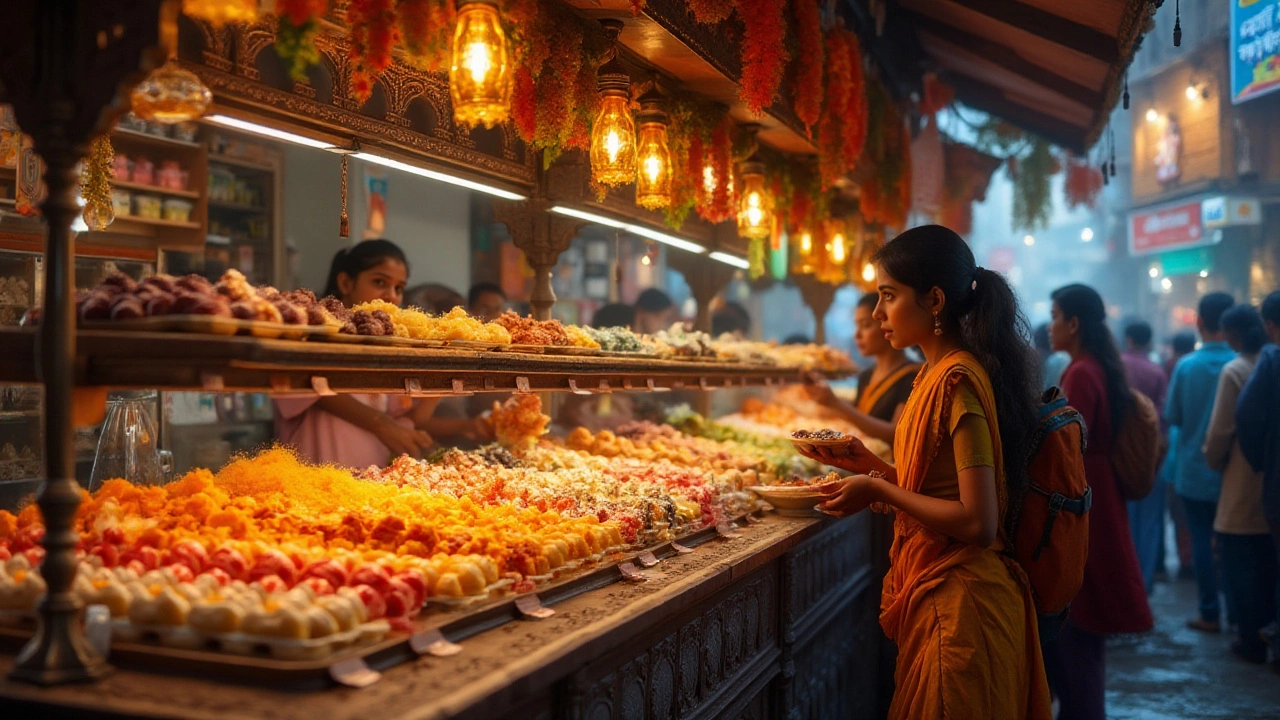9 Jan 2025
- 0 Comments
India, a land of vibrant cultures and traditions, offers a sweet journey through its diverse array of desserts. Each region in the country boasts a unique selection of sweets that reflect its history, climate, and local produce. Whether it's the saffron-infused flavors of the north or the coconut-rich creations of the south, Indian sweets are a celebration of taste and tradition.
At the heart of Indian desserts lies an artful combination of flavors and textures that captivate the senses. These delightful treats are not only a feast for the palate but also carry deep cultural significance, often enjoyed during festivals and special occasions. As you embark on this sweet adventure, you'll discover the intricacies of ingredients, preparation techniques, and the regional variations that make Indian sweets truly special.
- The Cultural Significance of Indian Sweets
- Popular Ingredients Used in Indian Desserts
- Exploring Regional Varieties
- Iconic Indian Sweets You Must Try
- Tips for Making Authentic Indian Sweets at Home
- Pairing Indian Sweets with Meals and Beverages
The Cultural Significance of Indian Sweets
In India, the creation and sharing of sweets are deeply entwined with the cultural and religious fabric of society. Indian sweets, known as mithai, play an integral role in the country's diverse cultural landscape. These culinary delights are not merely desserts; they are symbols of auspiciousness and a medium for celebration across the subcontinent. During festivals like Diwali, Eid, and Holi, sweets are prepared with intricate care and shared with family and friends as a gesture of goodwill and happiness. The pervasive presence of sweets during such times speaks volumes of their importance—indeed, a festival is incomplete without the savoring of these delectable treats.
Moreover, mithai holds a prestigious place in ceremonies and rituals, signifying purity and prosperity. For instance, no traditional Indian wedding is considered complete without the distribution of sweets. From the bride's and groom's families exchanging delicacies as tokens of gratitude to guests enjoying a feast of sweets at the reception, these delightful desserts symbolize the sweetness of the couple's new journey. According to the National Geographic, "In India, expressing happiness is synonymous with sharing sweet treats, an age-old tradition that transcends generations."
The religious aspect cannot be overlooked either. Certain sweets are offered to deities in temples and at home, believed to invoke blessings and fulfill wishes. One such example is the modak, a sweet dumpling delicacy favored by Lord Ganesha. During Ganesh Chaturthi, thousands of modaks are prepared and offered, exemplifying devotion and cultural heritage through culinary art. These practices highlight how sweets are woven into the spiritual and everyday lives of millions of Indians.
With every bite of Indian sweets, one uncovers a historical narrative—the colorful tales of origin, regional adaptations, and family recipes passed down through generations. Many sweets can be traced back to ancient texts, illustrating their enduring place in society. These desserts often showcase the diversity of India's culinary techniques, incorporating ingredients like jaggery, nuts, milk, and ghee to create unique flavors that tantalize the taste buds. This diversity not only showcases India's rich culinary heritage but also fosters a sense of pride and nostalgia among its people.
Popular Ingredients Used in Indian Desserts
The magic of Indian sweets lies in their ingredients that bring out the unique flavors and textures, cherished by people worldwide. A key ingredient often used is milk and its derivatives, such as khoya and paneer, which give desserts like gulab jamun and sandesh their rich, creamy consistency. These dairy products are meticulously cooked down to enhance their sweetness and depth of flavor. Often, you'll find nuts like almonds, pistachios, and cashews dotted generously across many desserts, adding a delightful crunch. These nuts are not only a treat for the taste buds but are also packed with nutritional benefits, making the sweets both indulgent and wholesome.
If you venture into the kitchens of Bengal, the primary ingredient you'll encounter is chenna, which is a type of fresh, unripened curd cheese used to make sweets like rasgulla and cham cham. It’s the simplicity of chenna that allows the infusion of sugar syrup to shine, creating sweets that are light and spongy. Sugar, being the universal sweetener, finds its omnipresence in most of these desserts, either in crystal form or in syrup. Saffron and cardamom are essential spices, with their aromatic notes transforming desserts into an exotic experience. Each pinch of these spices tells tales of royal feasts and opulence, resonating with every bite.
The diversity of ingredients doesn't stop here. Coconut holds a special place in the hearts of the southern regions, where it features prominently in recipes like coconut laddoos and payasam. The subtle sweetness and texture of fresh grated coconut, combined with cardamom or jaggery, offer a taste that is distinctively tropical. To add to this rich tapestry, gram flour and semolina are regularly used to create sweets like besan ladoo and suji halwa, known for their dense, satisfying texture. Gram flour lends a nutty savoriness that balances the sweetness, while semolina gives a fine grainy texture, making each mouthful a delightful journey.
"The diverse ingredients used in Indian sweets not only enhance the flavor but are a testament to the rich cultural tapestry of India," says culinary expert Monica Bhide.
It's fascinating to note how these basic ingredients are transformed into an endless variety of desserts. Take jaggery, a traditional sweetener, for instance. Unlike refined sugar, jaggery has a complex flavor profile that includes earthy and caramel notes, making it a preferred choice in many rural sweet recipes. Gram flour, similarly, is valued for its adaptability, being used not just for sweets, but also in snacks and savory dishes, highlighting the versatility of Indian cooking techniques. These ingredients, along with rose water and kewra essence, are like symphonic notes that play together harmoniously, creating desserts that are hymns to the palate.

Exploring Regional Varieties
India's vast and diverse landscape is reflected gloriously in its culinary repertoire, especially when it comes to Indian sweets. These sweets are as varied as the country's geography, with each region offering something unique and intimately tied to its tradition and local ingredients. In the northern parts of India, sweets like Ladoo, made with gram flour and ghee, warm hearts and stomachs with their rich, nutty flavor, often perked up with hints of cardamom. Punjab's pride, the beloved Pinni, is not just a treat but a testament to the state's agricultural bounty, using wheat flour and jaggery in a symphony of warmth and indulgence.
In the eastern region of India, where Bengal steals the limelight, rasgulla reigns supreme. This soft, spongy delight is crafted from fresh chenna, a type of domestic cheese, and soaked meticulously in a light, sugary syrup. Bengal's sweets often share a common base of milk and intricate art of chenna-making, which speaks volumes of the region's dairy farming heritage and skilled craftsmanship. A quote from Rabindranath Tagore famously praised the rasgulla as a "sumptuous delight that transcends all emotions." It's no wonder that these desserts form a core part of Bengali festive celebrations.
Journeying to the lush south, where coconut and jaggery play a pivotal role, sweets such as Mysore Pak allure with their melt-in-the-mouth texture. Originating from Karnataka, Mysore Pak is revered for its simplicity and legacy. Made with gram flour, sugar, and copious amounts of ghee, it offers a taste that's both rustic and heavenly. Tamil Nadu lends its voice with the classic Payasam, a rice-based pudding rich with nuances of cardamom and saffron, often laced with cashews and raisins, showcasing southern India's rich spice culture.
The western lands, featuring the culinary artistry of Gujarat, offer the world a taste of sweet-savory treats like the iconic Dhokla, when combined with sweet imli chutney, and desserts like Basundi—a luscious, simmered milk concoction flavored with saffron and cardamom. Maharashtra's Shrikhand, a yogurt-based delicacy, is cherished for its creamy texture and refreshing zing of cardamom and saffron, bringing lightness and joy to every mouthful.
Even within these regions, town-to-town variations showcase how local flora, fauna, and cultural practices can influence the making and flavor of sweets, making the exploration of Indian sweets a never-ending adventure. Whether sourced from bustling city bazaars or quiet village markets, these delicate treats are not mere confections; they are narratives, each bite offering a story steeped in tradition, waiting to be savored.
Iconic Indian Sweets You Must Try
When it comes to Indian sweets, there's an entire universe of flavors and textures waiting to be explored. These delectable treats are as heartwarming as they are diverse, each one introducing you to a different facet of India's rich culinary heritage. A must-try is the delightful gulab jamun, often considered a quintessential Indian dessert. Small, round, and fried to golden perfection, these sweet dumplings are soaked in fragrant sugar syrup flavored with cardamom, making them melt-in-your-mouth soft and decadent. Graceful in their simplicity yet rich in flavor, they are enjoyed across the country during festive seasons and celebrations.
No exploration of India's sweets would be complete without tasting the spongy rasgulla. Originating from the eastern part of India, particularly West Bengal, this sweet dish is made from ball-shaped dumplings of chenna (an Indian cottage cheese) cooked in thin sugar syrup. Its soft texture and delicate taste make it a beloved favorite. Equally enchanting is the jalebi, known for its luminous yellow-orange hue and spiraled shape. Often enjoyed piping hot, jalebis are made by deep-frying batter into circular shapes and then soaking them in syrup, providing a crunchy exterior and a saccharine interior.
A famous Indian chef once remarked, "Indian sweets not only feed the body but also the soul, connecting generations through timeless tastes and traditions."
Another all-time favorite is kheer, a creamy rice pudding infused with cardamom, saffron, and generously topped with nuts and raisins. Kheer embodies the essence of comfort food for many, served on quiet family dinners and lavish feasts alike. Meanwhile, the translucent charm of Barfi is unforgettable. Available in various flavors like coconut, pistachio, or the aromatic besan (gram flour), they have a fudge-like consistency that captivates the senses.
Regional Variants and Their Specialty
Every region adds its own twist. For instance, Maharashtra boasts puran poli, a sweet flatbread packed with jaggery and chana dal filling, perfect for those who seek solace in comfort food. In the south, one cannot miss the multifaceted mysore pak, originating from Karnataka. Its rich, velvety texture is due to the saturation of ghee, which binds the chickpea flour and sugar, creating a sweet symphony for your taste buds.
Indian desserts are not only about taste but are embedded with cultural stories, making them essential in understanding the local heritage. As these classics continue to charm dessert lovers worldwide, they encourage us to experiment with flavors and techniques, ensuring their legacy. Whether you're enticed by the sugary swirl of jalebi or the cloud-like texture of rasgulla, indulging in these sweets is an invitation to experience a slice of India's cultural and culinary identity.

Tips for Making Authentic Indian Sweets at Home
Creating authentic Indian sweets at home can be an enriching and rewarding culinary experience. The process often involves a mix of patience, precision, and passion for flavors. A fundamental tip is to understand the core ingredients used—be it the velvety richness of condensed milk, the earthy aroma of cardamom, or the delicate essence of saffron. Familiarizing yourself with these ingredients helps not only in making desserts that taste authentic but also in appreciating the essence of traditional recipes.
One crucial aspect is choosing the right kind of dairy. Many Indian desserts rely heavily on milk-based products, so it's important to pick fresh, unpasteurized milk if possible, as this greatly enhances flavor and consistency. Ghee, or clarified butter, is often the fat of choice, imparting a distinct flavor that cannot be replaced by regular butter or oil. Moreover, mastering the art of making sugar syrup is essential since it forms the base for numerous sweets. The syrup's consistency should be just right—not too thick, not too thin—to lend the appropriate texture and taste.
Preparation methods often involve traditional techniques such as slow cooking or hand-kneading that could be time-consuming yet worth the effort. From boiling milk to the perfect consistency for making peda to shaping laddoos with precision, each step demands attentiveness. Employing the right cooking equipment is as important. Traditional tools like kadais (deep frying pans) and mortar and pestles for grinding spices and nuts can make a notable difference in the result. In some cases, using minimal modern kitchen equipment might provide a more genuine outcome, enhancing the authenticity of your sweets.
"The art of making Indian sweets lies in balancing flavors with skillful manipulation of textures," says Chef Madhur Kumar, a well-regarded culinary expert specializing in Indian cuisine.
Lastly, don't shy away from adding a personal touch. While it's crucial to follow traditional methods to capture the essence of authenticity, with experience, one can infuse these sweets with creativity. Adding a dash of rose water, experimenting with regional spices, or orchestrating the presentation can make your homemade desserts stand out, offering a delectable piece of India on your plate. Whether you’re a novice or a seasoned cook, these tips aim to guide and inspire your journey into the fragrant world of Indian confectionery.
Pairing Indian Sweets with Meals and Beverages
Indian sweets hold a special place in the culinary landscape, complementing not just celebratory moments but also everyday meals. The art of pairing these sweets with meals and beverages is a tradition that's evolved over centuries. Each pairing is a testimony to the refined palates of ancient Indian gastronomists who understood that a perfect end to a meal or an ideal accompaniment can elevate the dining experience to new heights.
"Pairing is all about harmony," mentions culinary historian Maya Shaan. "The balance between the savory and sweet, spicy and dulcet, is what makes Indian cuisine so profoundly satisfying."To appreciate the beauty of this art, one must first understand the variety. For instance, desserts like gulab jamun are a popular pick to round off spicy North Indian meals, owing to their soft, syrupy sweetness. They provide a soothing contrast to the rich curries and spices. Down south, the coconut and jaggery-filled obbattu, also called holige or puran poli, often follows a hearty feast of khara bhath or bisibele bath, ensuring a smooth transition from savory to sweet.
The art of pairing is not just confined to meals but extends to beverages, an area where imagination can play a delightful role. Indian tea, known for its strong aromas and flavors, such as chai with its ginger and cardamom notes, often embraces sweets like kaju katli and peda. The spicy warmth of the tea dances gracefully with the cooling sweetness of these confections. Similarly, coffee aficionados might find that a strong South Indian filter coffee pairs sublimely with soft mysore pak or badushah, the hints of bitterness highlighting the sweets’ subtle caramelization.
Moreover, some modern explorations into Indian sweets blend them with alcoholic beverages. For instance, a mature single malt can interestingly complement the nutty richness of a pista barfi, each sip bringing out the dessert’s earthy flavors. Meanwhile, sweet wines are increasingly being paired with Indian desserts, with a chilled late-harvest wine meeting its match in chilled rasgulla or sandesh. This fusion represents a beautiful amalgamation of ancient Indian traditions with global culinary trends.
Ultimately, the world of pairing Indian sweets with meals and beverages invites continuous innovation and discovery. Its beauty lies in the subtle dance of flavors—a dance that, when done rightly, can turn any ordinary meal into an extraordinary culinary journey. Whether you're an adventurous explorer or a careful traditionalist, there's a world of sweet pairings awaiting your exploration.
